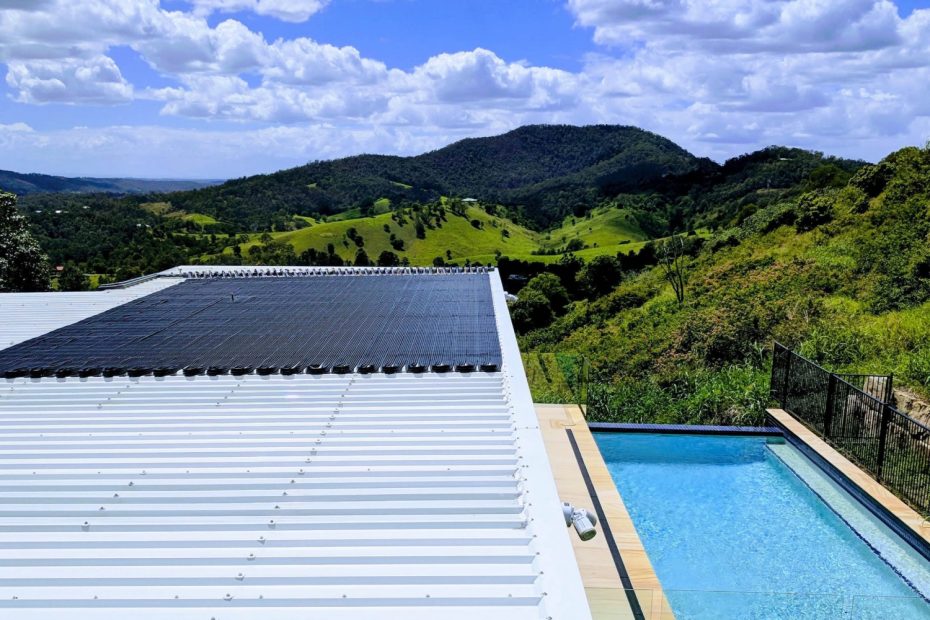As the weather cools down and winter approaches, many pool owners start to think about ways to keep their pool warm so they can continue to enjoy swimming and other water activities during the cooler months.
Luckily, there are a variety of pool heating options available to help extend the swimming season and keep your pool at a comfortable temperature. Just imagine how rejuvenating your heated pool will be in the winter, especially when built with the top 2023 pool trends.
In this article, we will dive into the different types of pool heating options available and explore their unique advantages and disadvantages. We’ll also take a closer look at the technical specifications of each option so you can make an informed decision on which method will work best for your needs.
Gas Heaters
Gas heaters are the most powerful of the bunch, and they can heat a pool to the desired temperature in as little as 24 hours, even in colder temperatures. This is based on a temperature rise of around 12-14 degrees, which is perfect for those spontaneous winter pool parties. Gas heaters are commonly used in spas, but they have also gained popularity among pool owners who want to heat their pool occasionally. With their ability to quickly heat up a large amount of water, gas heaters are an effective option to warm up your pool.
But with great power comes great responsibility – and in this case, great expense. Gas heating is an expensive option compared to other methods, with ongoing costs of refilling the gas tank. This can add up over time and may not be the most economical option for those looking for a long-term solution to keeping their pool warm.
It’s also important to consider the environmental impact of gas heaters. Gas heating systems produce greenhouse gas emissions, which contribute to climate change. In Australia, the residential sector is responsible for around 10% of the country’s greenhouse gas emissions, with heating and cooling being a key contributor.
Solar Heating
Solar heating is an excellent option for those looking for a cost-effective and environmentally friendly solution. In Australia, where the sun shines brightly for most of the year, solar pool heating is a popular choice. According to the Clean Energy Council, there are more than 1.6 million solar water heaters installed across Australia, and that number continues to grow.
With solar heating, pool owners can harness the power of the sun to warm their pool, providing comfortable swimming conditions well into the cooler months. No wonder pool owners can still reap the wellness perks of an outdoor pool despite the cold season. The system is simple, consisting of a series of panels installed on the roof, which circulate water from the pool through a filter and back into the pool. Solar heating systems can double the swimming season, and in some cases, even triple it, providing an excellent return on investment.
One of the biggest advantages of solar heating is its affordability. Once installed, solar heating systems have no ongoing costs, making them an excellent long-term investment. Solar heating is also eco-friendly, producing no greenhouse gas emissions and contributing to a more sustainable future.However, it’s important to note that solar heating is reliant on weather conditions. On cloudy or overcast days, the heating process may not be as effective, and the water temperature may not reach the desired level. Despite this, solar heating remains a popular choice for pool owners looking for a cost-effective, eco-friendly, and efficient way to extend their swimming season.
Electric Heat Pumps

Electric heat pumps are one of the most energy-efficient and eco-friendly options available. These clever devices work by extracting heat from the air and transferring it to the water in your pool, making them incredibly efficient. In fact, electric heat pumps can provide several times more energy than they consume, which makes them a very cost-effective choice.
Moreover, electric heat pumps can be connected to off-peak or time-of-use electricity pricing, making them even more economical. According to internal research, over 40% of pool owners in Australia choose electric heat pumps as their preferred heating method.
However, to get the most out of your electric heat pump, it’s important to use a pool cover. A pool cover helps to keep the heat in the pool overnight and prevents it from escaping, which ultimately saves energy and money. So, if you’re looking for an efficient and eco-friendly way to heat your pool, electric heat pumps with a pool cover are an excellent choice.
At Blue Haven Pools & Spas, we understand that owning a pool is more than just a luxury, it’s a lifestyle. We want to ensure that our clients can enjoy their pool year-round, no matter the weather. Our experienced pool builders are knowledgeable about all types of pool heating systems and can provide you with the best options for your specific needs, preferences, and budget. We take pride in our work, and we ensure that every pool we build comes with heating provisions, so you can add a heating system at any time in the future.
Don’t let the colder months limit your swimming season, contact us today to explore your pool heating options and take the first step in creating the ultimate backyard oasis. Additionally, read our tips on the top three things you can do with your pool during winter. With our expertise and commitment to quality, you can trust that your pool heating needs are in good hands.
